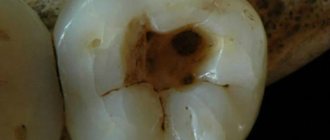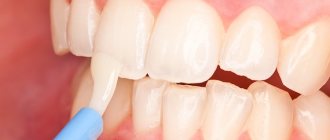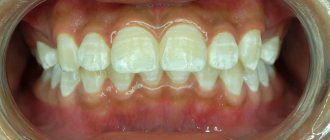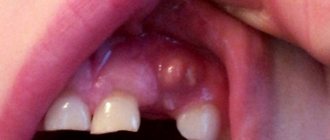What is dental fluoridation?
Fluoridation of teeth is a type of therapeutic effect on the surface of teeth, which helps strengthen them and prevents the development of many diseases.
This procedure is indicated both for thinning tooth enamel and as a prevention of caries. In the process of its implementation, various types of medicinal compositions are used. All of them enrich tooth enamel with fluoride ions - the most important mineral responsible for the strength and longevity of teeth. Regular fluoridation of enamel reliably protects teeth from the negative effects of acidic environments and harmful bacteria. First of all, fluoridation of enamel is recommended:
- Persons with increased tooth sensitivity;
- With a high risk of developing caries.
The procedure is absolutely painless, so it can be performed even on the youngest patients.
Why is tooth enamel destroyed?
The main cause of enamel destruction is the accumulation of organic acids in the oral cavity. Weakened, or demineralized, enamel is unable to withstand environmental risk factors. This inevitably leads to bacteriological contamination and increased sensitivity of the teeth.
Causes of enamel demineralization:
- Unhealthy diet;
- Low fluoride content in drinking water;
- Lack of calcium in the body;
- Pathogenic microorganisms in the oral cavity;
- Violations of the chemical composition of saliva;
- Negative impact of external factors;
- Insufficient oral care;
- Age-related changes.
These factors affect the condition of the oral cavity and the strength of tooth enamel. Weakened enamel is not able to fight the proliferation of cariogenic bacteria. The interaction of microorganisms that make up dental plaque leads to the formation of a carious lesion. This means that microdefects appear on the enamel surface. Prolonged neglect of demineralization will result in the stronger layers of enamel being affected over time. As a result, a comfortable environment is created for the proliferation of pathogenic bacteria and accelerated tooth decay.
Fluoridation of tooth enamel will help stabilize the condition and compensate for the lack of minerals.
What is fluoridation of teeth?
There are several methods of fluoride prevention of dental caries. The optimal solution would be the integrated use of a systemic and local source of fluoride, since the isolated use of one method may be insufficient.
Types of fluoridation:
- Drinking fluoridated drinking water;
- Fluoride tablets;
- Cleaning your teeth with a toothpaste containing fluoride;
- Simple fluoridation;
- Deep fluoridation.
Systematic consumption of fluoride-enriched water increases the concentration of fluoride ions in saliva and the oral cavity. This can compensate for the deficiency of fluoride in dental plaque and in the upper layers of enamel. However, in cases of severe demineralization, oral fluoride prophylaxis may not be sufficient. There are frequent cases of caries among adolescents, since external drugs are not able to penetrate thick layers of plaque.
Simple fluoridation of teeth
Simple fluoridation is carried out in the clinic in two ways:
1. Gel fluoridation course;
Before the procedure, the dentist removes plaque from the surface of the teeth and isolates the tooth surface from saliva using cotton pads. A special mouthguard that follows the shape of the teeth is filled with fluoride-containing gel and applied to the surface of the teeth for 5-10 minutes. Then the excess drug is removed from the oral cavity. After completing the procedure, you should refrain from drinking and eating for two hours.
In order for fluoride ions to penetrate the tooth enamel as deeply as possible, it is recommended to undergo the procedure up to 10-15 times (as prescribed by the doctor). The course should be repeated every six months.
2. Strengthening the enamel with sealing varnish.
Prolongs the effect of enamel fluoridation. The dentist cleans and dries the surface of the teeth. The varnish is applied with a brush to the surface of the enamel from the inside and outside and dried again. After which it hardens on the teeth, forming a fluoride-sealing film on the enamel, which remains in the areas of demineralization for up to several weeks. After applying fluoride varnish, it is not recommended to eat solid food or brush your teeth for 12-24 hours. Even a single application of varnish increases the concentration of fluoride in enamel by up to 77%. The procedure is painless and effective for children. The frequency of repetition depends on individual indicators and is determined by the attending physician. In most cases, this is 2 times every six months.
However, despite a noticeable reduction in karyotic formations, simple fluoridation is effective only for superficial damage to the enamel. In order for calcium fluoride to penetrate deep into the enamel, the deep fluoridation method is used.
Indications for the procedure
Due to the global deterioration of the environmental situation, poor nutrition, stress, the flow of natural processes in the human body is disrupted. In this regard, demineralization of enamel occurs much faster and more often than its restoration. Since tooth enamel covers dentin, which is very sensitive to an acidic environment, the destruction of which occurs instantly and leads to tragic consequences for the tooth, the need to protect the enamel is obvious.
The main advantages of remineralization are:
- protection of dental tissues from the aggressive effects of acids;
- the ability to stop the initial stage of carious enamel destruction without the need for treatment;
- protection and restoration of damaged enamel after braces or whitening;
- reduction or complete elimination of increased sensitivity of teeth to hot and cold foods, as well as to sour and sweet foods.
Deep fluoridation of teeth
Deep fluoridation of teeth is a highly effective method of strengthening and local fluoride prevention of dental caries. The principle of operation of the procedure is to treat tooth enamel with a fluoride-based medicinal composition. Unlike previous methods, deep fluoridation is characterized by a more pronounced and lasting result.
Advantages of deep fluoridation:
- Increased content of fluorine-containing components;
- Protection against the development of caries;
- Strengthening tooth enamel;
- Extending the service life of fillings;
- Reduced tooth sensitivity;
- Easy to carry out;
- Affordable pricing policy.
The results of scientific research and patient reviews have repeatedly confirmed that deep fluoridation of enamel reduces tooth sensitivity and protects them from destruction over time.
The deep fluoridation method consists of sequential treatment of hard tooth tissues with a special fluoride-containing solution. Filling demineralized areas and microcracks, the substance penetrates the enamel. The surface of the tooth is compacted, a reliable crystalline and bactericidal barrier is created, protecting the tooth from destruction.
Thanks to careful processing, fluoride ions lie not only on the surface, but also deep in the pores of the enamel. This prevents their premature leaching and prolongs the effect of deep fluoridation from six months to two years. In addition, there is a constant release of fluoride ions in the concentration necessary to completely restore the enamel structure in the area of demineralization.
What is fluoride varnish and how does it work?
The composition of fluoride varnish includes:
- shellac,
- sodium fluoride,
- fir or cedar balsam,
- chloroform,
- ethanol.
It is a viscous dark brown composition with a pine smell. Coating teeth with fluoride varnish creates a protective film that remains on the enamel for a long time. In doing so, it operates as follows:
- affects microorganisms on the surface of the tooth, preventing them from absorbing glucose and releasing acid that destroys enamel;
- interacts with the enamel, forming a hard layer that serves as a kind of shield for the teeth;
- absorbs calcium contained in saliva, restoring the mineral structure of the enamel, saturating it with necessary elements;
- has a positive effect on the gums, making them more elastic and stronger.
Thus, the use of fluoride varnish allows you to avoid many diseases associated with teeth, including caries and periodontitis. Applying varnish increases the service life of fillings and also reduces tooth sensitivity.
Contraindications and indications
Indications for using the deep fluoridation method:
- Treatment of hyperesthesia (high sensitivity) of teeth;
- Treatment and prevention of dental caries;
- Mineral (non-invasive) fissure sealing;
- Treatment of marginal periodontitis.
Contraindications:
- The presence of caries in the active stage;
- Excessive fluoride content in the body;
- Having an allergic reaction to one of the components of the procedure;
- Severe toxicosis during pregnancy.
Despite the simplicity and safety of this procedure, you should consult your doctor before performing it.
Stages of fluoridation
Deep fluoridation of tooth enamel is carried out in several stages:
- Cleaning teeth and interdental spaces from plaque;
- Drying teeth;
- Application of medicinal composition No. 1 (calcium and magnesium fluoride) to the enamel surface;
- Application of preparation No. 2 (calcium hydroxide);
- Removing drug residues.
You can eat food immediately after the procedure. To consolidate the result in the first hours, it is recommended to avoid too hard and hot foods. Deep fluoridation is carried out without pain and is safe for children.
Fluoridation of teeth at home
Fluoridation of teeth can be done at home. This is the simplest and most affordable care using fluoride-containing pastes, fluoridated water and special medications. These funds will allow you to extinguish foci of demineralization, but to a much lesser extent than similar procedures in the clinic.
Fluoridation of teeth at home:
- The most popular method is to use fluoride paste. It not only prevents the appearance of caries, but also fights the appearance of plaque and tartar. For greater effectiveness, you should hold the paste on your teeth for a minute, rinse your mouth and do not eat for an hour;
- Mouth rinses with a high fluoride content disinfect the oral cavity from pathogenic bacteria, whiten teeth and enrich the enamel with fluoride and beneficial microelements;
- Fluoride varnishes and gels, which are commonly used in dentistry, can be purchased at the pharmacy. They should be used according to the instructions and only after consulting a doctor.
- You can compensate for the lack of fluoride literally “from the inside” - with the help of special medications in the form of tablets containing fluoride. The dosage and need for taking such a medicine should be determined by a doctor after examination and testing.
Important! An excess of fluoride is no less harmful than its deficiency, so self-medication can be dangerous to your health!
How to protect baby teeth from caries
Fissure sealing is an effective method of caries prevention. But you can't rely on the dental procedure alone. To maintain and preserve the health of children's teeth it is also necessary:
- Proper nutrition - more solid vegetables and fruits, fermented milk and dairy products, minimizing sweets.
- Systematic dental care - you need to brush your teeth twice a day, and when correcting your bite with braces, after every meal.
- Scheduled visits to the doctor - dentists invite you for an appointment every six months, and sometimes more often.
- Selection of toothpaste and toothbrushes according to age - when purchasing care products, you should focus on the dentist’s recommendations.
Pediatric dentistry today offers non-invasive and invasive techniques for fissure sealing. When choosing a doctor, you should focus on the dentist’s experience, reviews and recommendations. To increase the effectiveness of the procedure, make an appointment immediately after the chewing surface has erupted - when the crown becomes visible and accessible for treatment.











